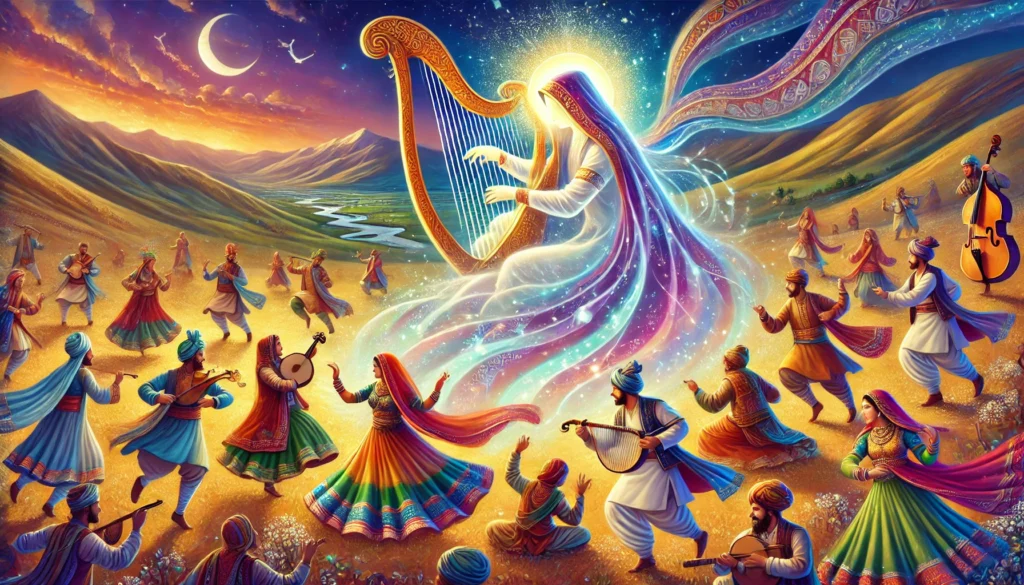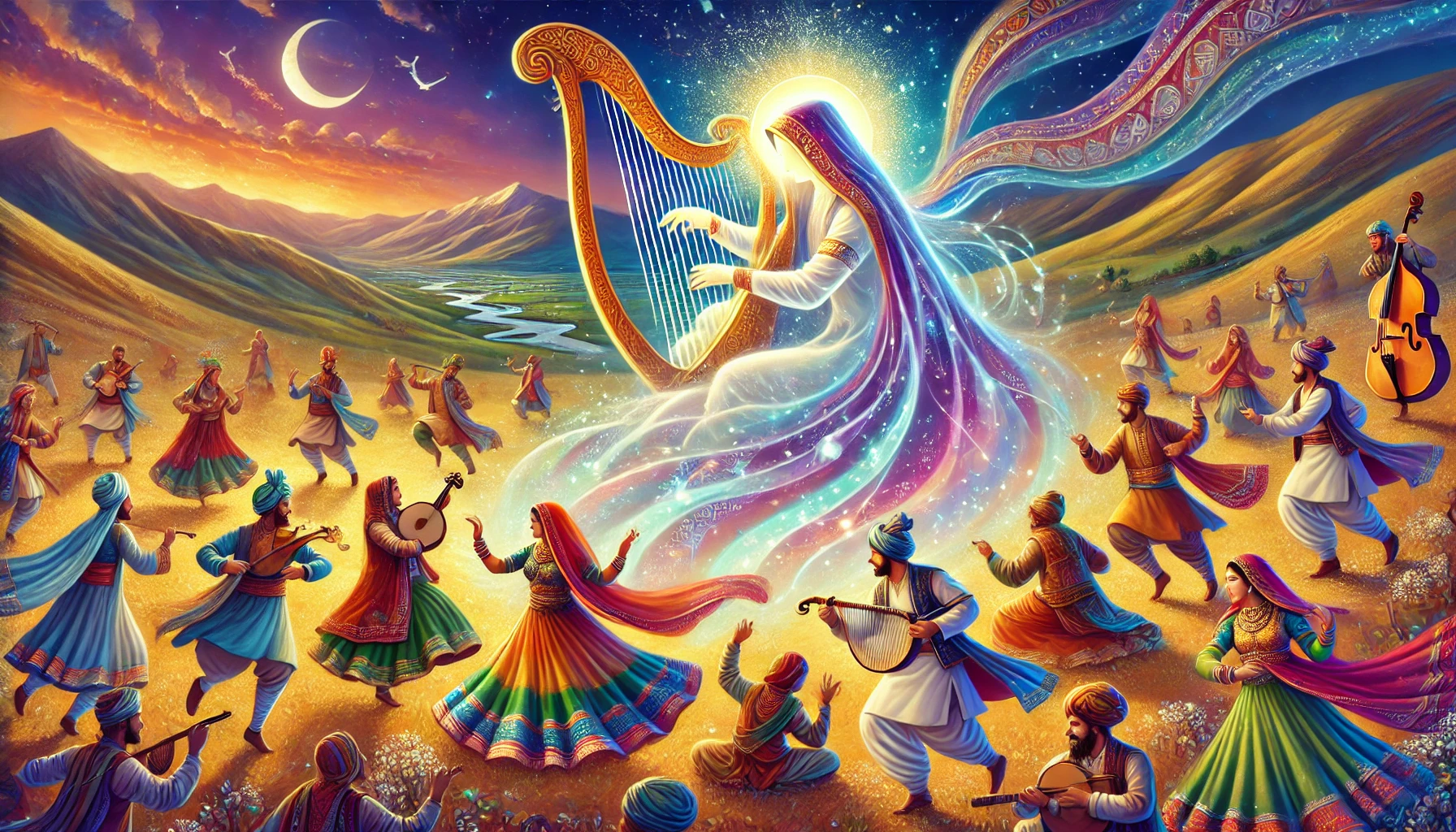
A Tale of Melodies Across Time
A Tale of Melodies Across Time by Visualizing the Journey of Folk Evolution
Picture a timeless traveler, a bard with a golden harp, journeying across epochs and lands. In one hand, she holds an ancient drum, its taut skin humming with primal rhythms. In the other, she clasps a scroll filled with tales of gods, love, and defiance. Her story begins in a lush valley, winds through bustling empires, and dances into the modern age. This is the tale of folk traditions, a vibrant narrative of humanity’s collective creativity. Today, we focus on Northern Indian folk arts, whose vibrant hues illuminate global parallels, revealing shared patterns of cultural expression.
Ancient Beginnings (3000 BCE – 1000 BCE)
In the cradle of the Indus Valley, where rivers carved life into the land, villagers gathered around roaring fires. Clay figurines suggest ritual dances, while relics of lyres and drums whisper of a burgeoning musical tradition. Their melodies mirrored nature—the rustle of leaves, the roar of monsoons.
Beyond these borders, similar notes played. In Egypt, priests strummed harps beneath pyramid shadows, while in Mesopotamia, artisans crafted the Tambour, an ancestor of India’s Sarangi. Across these lands, folk traditions celebrated the rhythm of sowing seeds, the joy of harvest, and the mystery of celestial cycles.
Themes: Nature worship, agricultural rhythms, and mythic storytelling.
Vedic Age (1500 BCE – 500 BCE)
The bard’s journey takes her to the chanting priests of Northern India, reciting the Samaveda. Their hymns were no mere verses but songs entwined with devotion, laying the foundation for folk melodies like Uttarakhand’s Jagars, where spirits and deities wove themselves into the human world.
In Greece, bards like Homer recounted heroic epics, their lyres echoing battles and divine wrath. Meanwhile, Egyptian temples filled with ceremonial music that paralleled the Vedic chants, creating universal motifs of heroism and cosmic order.
Themes: Heroic sagas, divine interventions, and universal harmony.
Classical Period (500 BCE – 1200 CE)
As empires rose, so too did music’s sophistication. In Northern India, classical Raagas flowed into folk genres like Rajasthan’s Maand and Uttar Pradesh’s Chaiti, creating melodies that resonated with both courtly grandeur and rural simplicity. Epic tales like the Mahabharata inspired folk performances such as Pandwani, where bards transformed into warriors through song and gesture.
Across the Mediterranean, Roman theaters brought myths to life with music and dance, much like India’s Raslila. African griots began plucking the strings of the Kora harp, preserving tales of ancestry and valor.
Themes: Morality, romance, and the magic of local legends.
Medieval Period (1200 CE – 1700 CE)
Our bard now walks amidst caravans and courts, as cultures converge through trade and conquest. In Northern India, the mystical strains of Sufi Qawwalis blended Persian Rababs with native rhythms. Villages echoed with devotion, as Sufiana Kalam painted ethereal landscapes of love and longing.
Meanwhile, in European courts, troubadours strummed lutes, serenading queens with tales of chivalry. Sufi mystics across Africa and the Middle East breathed their spiritual yearnings into the soft whispers of Ney flutes. Everywhere, music became a conduit for transcendence.
Themes: Mysticism, devotion, and soulful longing.
Colonial Period (1700 CE – 1947 CE)
The bard’s voice becomes a rallying cry as empires tighten their grip. In Northern India, folk traditions morph into acts of defiance. Powadas in Maharashtra and Birha in Uttar Pradesh sing of rebellion, while Punjab’s Bhangra dances celebrate resilience.
Across oceans, enslaved African communities forge spirituals and Blues, preserving identity amidst oppression. In Ireland, protest songs challenge British rule. The melodies of resistance echo across continents, a testament to the indomitable human spirit.
Themes: Freedom, resilience, and the power of community.
Modern Era (1947 CE – Present)
With independence, the bard’s songs take on new dimensions. Northern Indian folk arts bloom at festivals like Surajkund Mela, where ancient crafts and music meet modern audiences. Instruments like the Sarangi find global acclaim, weaving into fusion genres and Bollywood hits.
Globally, the Dhol’s thunderous beats energize music festivals, and Bhangra teams dazzle in international competitions. The bard’s journey has become a bridge between worlds, where local traditions inspire universal unity.
Themes: Celebration, cultural pride, and global interconnectedness.
Epilogue
The bard stands at the crossroads of history, her harp now strung with threads from every age and land. Her story reminds us that folk traditions are not relics but living testaments to humanity’s shared creativity. Whether in the earthy rhythm of a village drum or the soaring notes of a festival stage, the spirit of folk evolution endures—a melody forever entwined with the heart of humankind.
Multilingual Folk Song Explorer GPT
Engaging and comprehensive folk song guide with interactive and multimedia features.
Multilingual Folk Song Explorer
Make your own folk website online!
Turn your passion into profit today and start your own online journey. Learn how to create and grow your website withna fabulous community and join for free!


